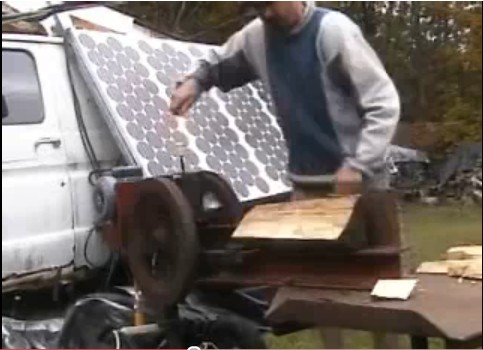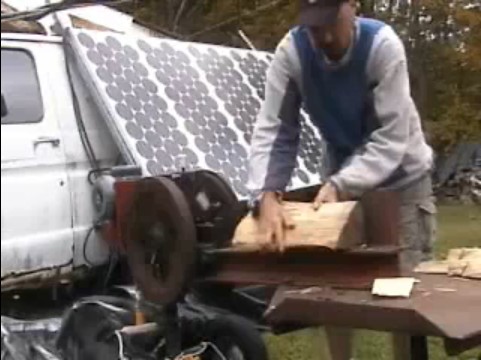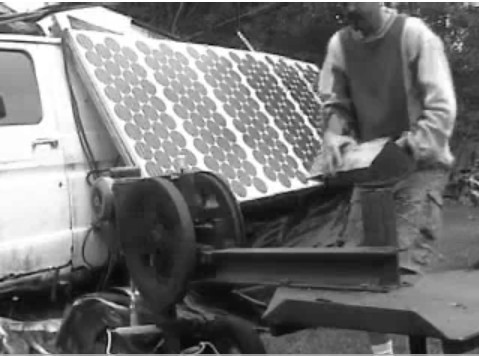Disclaimer:
Disclaimer: I assume no liability for what you may see on this page. In the same way that some people should never have any sharp objects, I do not advocate or encourage doing anything shown on this page. With that said, proceed at your own risk and enjoy the show!
CrazyJerry
The Task:
- Find a logsplitter that will hold up over the long haul and not break the bank!
- Make sure there is a readily available parts base in case of a failure.
- Since I am my own warranty, simplicity and customer support are mandatory!
- Should be as fast or faster than mainstream wood splitters.
- Must be of a tolerable noise level since it may be inside the house/woodshed during inclement weather.
- Finally, it has to be very fuel efficient or it will not fit into my off-grid endeavor.
This was not an easy task, but with persistence there is a simple solution that meets all of the criteria!
The Solution:
Electrified SuperSplit Woodsplitter! In the 80's a company under the name of Super-Split made a gasoline powered, flywheel based woodsplitter. The engine was quite small and was only really needed to spin up the flywheels. The inertia from the spinning flywheels would provide enough punch to move the toothed rack and wood chunk into the sharp wedge to split the wood. These units when properly maintained, have an incredible lifespan. This one is shown with the cover off to expose the the rotating flywheels. By simply replacing the original Honda gas engine with a 3/4 horsepower (559 watt) electric motor, we now have a very quiet and efficient woodsplitter. The ram takes about three seconds to extend and split the piece of wood, and just one second to retract and be ready for the next split.
In the left side photo, the rack is engaged and the flywheels are extending it outward. This sends the wood into the sharp wedge to be split.
In the right side photo, the rack is disengaged and a stout set of return springs promptly pull it rearward and away from the sharp wedge. This allows for a new piece of wood to be placed on the beam and ready to be split.


Observations:
When running, the DC power draw at the AC inverter shows about 50 amps (for reference, the Dirt Devil Vacuum eats 110 or so DC amps). The pulley on the electric motor that drives the flywheels via a v-belt, can be larger to provide: faster flywheel rotation (which will give more splitting force but will stress the geared rack/ram more).... or the pulley can be smaller to provide: a slower flywheel speed with a faster recovery (should they slow down). Every project should incorporate a large safety factor to enhance longevity. In this case, the belt tension is minimal so in the event of a flywheel stall scenario (a huge knot in the wood), the belt will slip on the flywheels (this allows them to stop and will immediately reduce impact stress on the rack, and allow the electric motor to spin happily and stay cooler. This is superior as opposed to encountering a direct stall situation where the small electric motor would be maxed out trying to recover the non-existent spinning action of the flywheels.)
Additional Remarks:
This setup works excellent with either the Trace 2512 (12 volt, 2500 watt pure sinewave inverter), or the Magnum MS2812 (12 volt, 2800 watt pure sinewave inverter.) The Marathon 3/4 hp electric motor will "hum" and "run hotter" (and the speed is a bit slower) if using the Trace DR 2412 (12 volt, 2400 watt Modified Sinewave inverter). This is typical motor behavior when running a choppy modified sinewave as opposed to a pure sinewave where the motor wouldn't hum and it would run cooler.
Recently, a gaggle of participants who attended the 2010 LOCAL LIVING FESTIVAL visited my place during the Home Tours segment. There may have been some reservations about what this extremely quiet wood splitter could do with such a small motor. Judging from their reactions, I'd say this is no longer the case!
YouTube Video Clip of the ElectroSplit in action:
Please use this ElectroSplit video link if you do not want to use the embedded video below.
